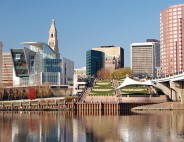California: Laying Claim to a Global Perspective
04 Jan, 2013
By Sharon H. Fitzgerald
Kish Rajan, director of the California Governor’s Office of Business and Economic Development (GO-Biz), has something simple to say about a California business locale: “We have a richness of resources that makes a really big impact on business,” he says. In fact, California is leading the nation in private-sector job creation, with more than 275,000 private-sector jobs created in the last year. “And that’s right at the top nationally,” Rajan notes.
Much of California’s strength lies in its West Coast location, and the result is a strong trade and exporting sector. All 12 metropolitan areas in California exported at least $2 billion in merchandise in 2012, with the Los Angeles region exporting nearly $80 billion. California’s largest market is Mexico, with exports totaling more than $26 billion. Canada, China, Japan and South Korea follow.
“We have very strong business partnerships and particularly trade and exporting partnerships with countries all over the world,” Rajan says. “If yours is a business that wants to or needs to avail itself of a global market, California is going to give you the best opportunity in the country.”
In fact, Rajan says GO-Biz is “reviving a dormant focus” on building export markets abroad, and its newest initiative is a partnership with the Bay Area Council, an industry-driven organization. The state agency is teaming up with the private-sector group to establish a California business office in Shanghai, set to open in early 2013. “It’s not going to be a government, bureaucratic-driven organization,” Rajan says. This public-private partnership model mindset is one state officials are working to replicate in other international locations.
California’s leading export category is computers and electronic products, which alone accounts for about 30 percent of the state’s export total. Illustrating the breadth of California’s economy is the fact that 44 percent of the state’s exported merchandise is manufactured by small and medium-sized firms.
Industries and Innovations
Technology is “embedded in our culture,” Rajan says. The result is that California has more high-tech jobs than any other state, with 930,000 people employed in high-paying jobs in the sector. Texas and New York don’t even come close. “It starts with our world-class university system,” Rajan says. “Technology is born from innovation — from the highest-quality research and development and invention.” Among the nation’s consistently ranked top 10 technology-oriented universities, three are in California — the University of California campuses of Berkeley, Los Angeles and Davis.
Rajan adds that the substantial presence in the state of military installations and national laboratories helps feed California’s technology bent. Those laboratories include Lawrence Berkeley, Lawrence Livermore, Sandia and the SLAC National Accelerator Laboratory operated by Stanford University. “There’s incredible capacity in our university system and our national laboratory system,” Rajan says. “There’s just this cauldron of innovation. Silicon Valley is the most well-known innovation cluster in human history.”
South of the San Francisco Bay area, Silicon Valley includes the city of San José. “People from all around the world and all over the United States who want to start companies and work on the forefront of the technology industry come here,” says Kim Walesh, San José’s director of economic development and chief strategist.
San José has an advantage over Silicon Valley locales such as Palo Alto to its north, Walesh says. In Palo Alto, home of Stanford University, land that’s still available is expensive. “But San José is the place in Silicon Valley where there’s room to grow,” she says. “There’s R&D space and office space available in the north San José technology district, as well as in downtown San José, which is emerging as Silicon Valley’s city center. San José is really the only place in Silicon Valley where there are still several greenfield sites available for development.”
When it comes to nurturing exports, San José as a city is a national leader. “I like to think of us as the East Coast capital of the Pacific Rim,” Walesh says. “In San José, we’re actually very oriented toward Asia.” The city-owned, newly expanded airport, Mineta San José, is a five-minute drive from downtown and the city’s technology area. On Jan. 11, 2013, the airport launches nonstop service to Tokyo via All Nippon Airways.
California’s location is a logistical benefit, and the city of Barstow embraces its logical advantage. The community is right between Los Angeles and Las Vegas and at the intersection of major highways, including interstates 15 and 40. “We have about 16 million cars that go through our little town on an annual basis,” says Margaret Carter, the city’s economic development administrator. That’s why Barstow is selling itself as an ideal location for distribution and warehousing operations. City leaders are working with the owner of an industrial park to bring rail service to the acreage, she says.
Basking in the High Desert, Barstow boasts 360 days of sunshine, and Carter says solar-related enterprises are discovering Barstow’s benefits. The city’s desert environment also attracts filmmakers. The new Barstow Film Office (www.filmbarstow.com) works to sell the Mojave Desert as a ready-made backdrop, and theatrical releases such as Erin Brockovich, Kill Bill and Courage Under Fire were filmed in Barstow.
Entrepreneurship is in itself a thriving California sector, and many communities are working to grow their economy from within. One is the city of Clovis, located in the Central Valley near Fresno. “We’ve made a strong push toward entrepreneurship, encouraging local businesses to start here and grow here and stay here,” says Tina Sumner, director of community and economic development. “We want Clovis to be that community where people have what they need to be successful.” To encourage startups, the city offers a two-year business license rebate as a pat on the back.
In early 2013, Clovis will launch a new initiative to support the area’s strong agriculture sector and spur growth in specialty-foods production. This micro-entrepreneur project will provide resources and training to nurture production and retail sales of products such as local honey and artisan cheeses. Sumner says the plan includes a co-op storefront in Clovis’ charming, historic Old Town.
Talent and Education
Since the economic recovery began in September 2009, California has gained more than 500,000 jobs. Professional and business services have posted the largest increase with 15,200 net jobs. Rajan says those numbers demonstrate that California’s workforce is highly skilled.
Capitalizing on the skill of California’s workers, GO-Biz launched its Innovation Hub initiative to stimulate job creation. “We have designated 12 regional innovation clusters across the state, organized around an institution of higher learning,” Rajan explains. The idea is to create “regional connectivity,” he says, among academia, industry, investors and workforce-development groups. These geographic iHubs focus on a sector such as renewable energy, health care, transportation, telecommunications and biotechnology. “It’s all about collaboration and truly finding partnerships,” Rajan says.
The value Californians place on education was put to the test in November 2012, when voters were asked to approve temporary tax increases to raise $6 billion a year to invest in public schools and the university system. The voters said yes to Proposition 30, which raises the state sales tax by one-fourth of 1 percent for four years and increases income taxes for seven years on those making more than $250,000 a year.
Assets
Communities willing to step up to the plate and invest in economic development are some of the most successful in California. The city of Redding, for example, developed the Stillwater Business Park after “listening to the needs of industry,” says Greg Clark, deputy city manager. Just 2.5 miles from Interstate 5 and adjacent to Redding Municipal Airport, Stillwater offers parcels of 100 acres or more for industrial and office development. The 700-acre park is shovel-ready, Clark says, because the city has already taken care of the permitting necessary, and water, wastewater, electricity, natural gas and fiber-optics are ready to go. Utility costs are low, thanks to the Redding Electric Utility, owned by the municipality. Clark says the utility is equipped to offer industrial rates 30 percent to 40 percent lower than investor-owned utilities in California.
In the state capital, the Sacramento Municipal Utility District works hand-in-hand with communities and their economic development leaders to retain and attract business. Greg Hribar, SMUD’s program manager for economic development and partnerships, says the utility will “tailor-make any specific programs that might be helpful to help business succeed. If incentives are important, we’ll make sure to outline what incentives might apply.”
SMUD may bring to the table utility discounts or offer businesses audits to help them conserve energy and thus trim costs. SMUD also offers a program to target businesses interested in buying energy from renewable sources. “Small businesses are important customers, and we want to make sure we’re taking care not only of our large ones, but the next Intel that might be blossoming in our region,” Hribar says. In 2012, the utility tied for the highest customer-satisfaction ranking from J.D. Powers and Associates among mid-sized utilities in the West.
“What people don’t know about Sacramento is we’re trying to get away from being known as just the policy center for California,” Hribar says. “There are amazing companies here – household names like Nestlé, Apple, Siemens, Intel — and they have all chosen to locate their business here. One of the main drivers is a competitive electric utility with the lowest rates in California.”
Lifestyle
California must be doing something right: nearly 37 million people call the state home, and its size ensures that businesses and individuals looking for their idea of the perfect community will be able to find it. California’s diversity also gives the state an edge. San José, for example, earned a unique distinction in a recent study by the Brookings Institution. Among the city’s college-educated population, half were born in another country. “We’re really a remarkably open and welcoming place, drawing on the top people from all over the globe,” Walesh says. “We’re very comfortable working across cultures and across borders.”
For complete information on conducting business in California, visit:
California Governor’s Office of Business and Economic Development
Sacramento Municipal Utility District
Down to Business
California’s annual exports total more than $120 billion.
California’s bank and corporation franchise tax is 8.84 percent on net corporate income
California’s R&D tax credit allows for a 15 percent credit against bank and corporation tax liability for qualified in-house research expenses and a 24 percent credit for basic research payments to outside organizations.
Businesses located in a California enterprise zone are eligible for a net operating loss carry-forward of up to 100 percent and can earn up to $37,440 in state tax credits for each qualified employee hired.
More than 2.4 million students are enrolled in 416 public and private colleges and universities in California with more than 200,000 college graduates per year.
Outdoors and Recreation
Experience coastal southern California as it once was with a trip to Channel Islands National Park. These five astounding islands harbor historical treasures as well as unique ecosystems on land and in the nearby waters. These tiny islands boast a biologic diversity that includes more than 2,000 plant and animal species — and 145 are found nowhere else in the world. Access is by park concessionaire boats from the mainland visitor centers in Ventura and Santa Barbara, or by small planes or private boat. Plan ahead.
Illustration by twobee at Free Digital Photos.net
Sharon Fitzgerald
Sharon Fitzgerald is a freelance writer from Murfreesboro, Tenn. She can be reached at fitzcomm@comcast.net.
Related Posts
-

PENNSYLVANIA: Ready to Grow with You
-

Arkansas: Melting Pot of Industries
-

Connecticut: Strong in Manufacturing & Tourism
-

Ontario: A Top Economic Leader in North America
-

California: Economic Growth on Fast Track
-

Innovation and Connections Energize Washington State
-

Governor Funds the Rebuilding of Rhode Island
-

Illinois Seeing Growth from Its Quality Workforce
-

Florida: Aerospace Flies Higher, Jobs Take Off
-

Wyoming Grows Technology and Innovation Assets









